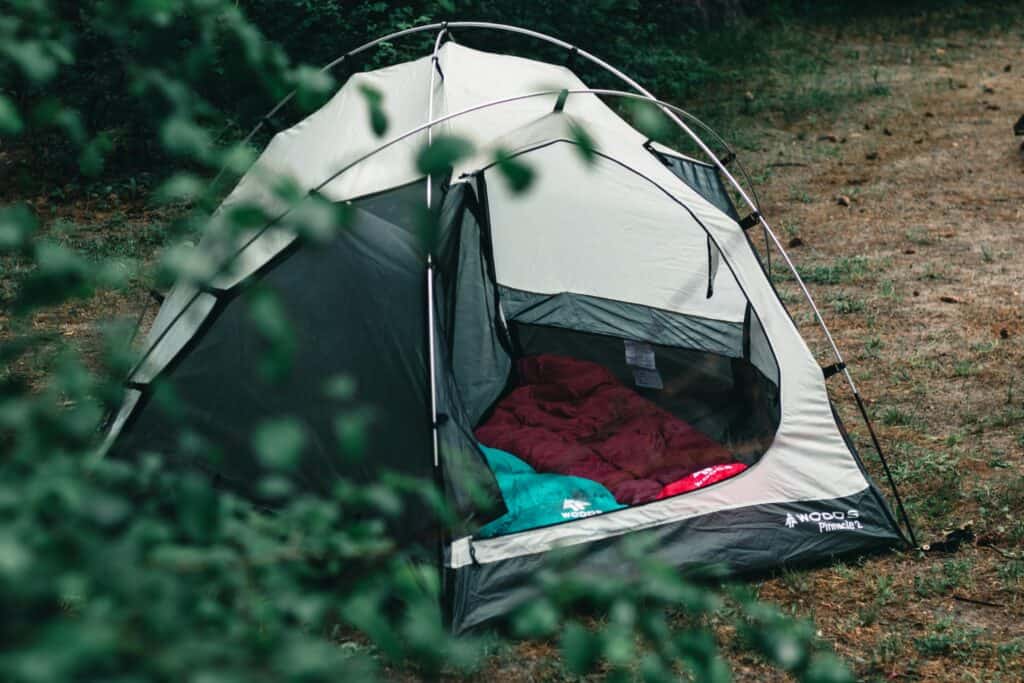Beginning campers as well as those new to camping with kids often wonder what kids should sleep in while you are camping.
Most kids will sleep in a sleeping bag on camping trips. Sleeping bags are designed to keep people warm in cold weather and can be purchased in sizes small enough for kids. Consider the comfort rating, size, and material when choosing a kid’s sleeping bag for your camping trip.
Learn everything you need to know about what your kids will need to sleep while camping.
What Do Kids Sleep in When Camping?
Most kids will wear regular pajamas and snuggle inside a sleeping bag when they are camping. While this is the typical situation, it isn’t the only option.
Warm-weather campers often don’t need a sleeping bag at all and are perfectly comfortable wearing shorts and sleeping with a blanket or two. In some areas, it can be too warm to sleep comfortably with even the lightest sleeping bag. Several times while camping in Florida we have slept with just a light blanket or sheet. On an early-October trip in the Keys, we had to sleep outside because the tent was just too stuffy and warm.
On the other hand, if the weather is cold, you might need to use sleeping bags that are rated for very cold temperatures and supplement them with blankets, extra pajamas, and thick sleeping pads in order to keep your kids warm. In the shoulder seasons in high-altitude areas, the temperatures can dip well below freezing at night, even when the weather is warm during the daytime.

Sleeping Bags for Camping With Kids
Sleeping bags are a good option because they help kids stay warm in cold weather, they are waterproof on the outside to keep dampness away, and because they have zipper closures kids are more likely to stay put and not lose their blankets in the night.
When you are choosing a camping sleeping bag for your kids there are several things to consider. The size of the sleeping bag, the temperature it’s designed for, the kind of insulation or stuffing it has, and the material the lining is made of are all important considerations.
Temperature Ratings
Before purchasing a sleeping bag for your child, make sure you check the temperature rating.
A kid’s sleeping bag should be rated at 50-60° for most summer camping trips. In areas with more extreme temperatures, such as the southeast or high altitudes, warmer or cooler bags might be required. Make sure that you are going by the “comfort” rating, not the “extreme” rating when choosing a sleeping bag for kids.
Many sleeping bags have three temperature ratings. The “comfort” rating is the temperature at which an average person may be comfortable in the sleeping bag. The “limit” rating is the lowest temperature at which a person might want to sleep in that sleeping bag. The “extreme” rating is the temperature at which a person should not experience hypothermia in a sleeping bag. This is why it’s important to use the comfort rating when choosing sleeping bags for your children.
Since most kids will be using their sleeping bags more than once and in a variety of locations, I recommend using a mid-range bag such as those rated for 40-60°. In general, it’s best to get a sleeping bag that is slightly too warm as you can always unzip it a little if your kids get hot. On the other hand, if you know your child sleeps hot and temperatures are usually warm, you can bring a sleeping bag rated for warmer weather.
Sleeping Bag Sizes
Sleeping bags are made in a range of sizes that are suitable for most kids older than toddler age. If your child’s sleeping bag is too large, they won’t stay as warm. However, if you get a bag that is too small they won’t be able to stretch out comfortably. When choosing a sleeping bag for your child, consider not only their current size but also how quickly they will grow. Try to find a bag that will fit your kids for a few years.
Sleeping Bag Materials
Sleeping bags are made of several different kinds of materials, including the material of the lining, the shell, and the stuffing. You will be most concerned with the shell and lining material for a kid’s camping bag. The stuffing will probably be a lightweight synthetic in most affordable, mid-range bags.
Most sleeping bags made for camping will have a waterproof outer shell such as polyester or nylon, which helps keep moisture and dampness out of the bag and keeps the stuffing and inner liner, along with your child, warm, dry, and clean. You can also find sleeping bags with an outer shell made of canvas. These are less waterproof but are very durable, and are so thick that most moisture won’t find its way inside to the sleeper.
Ideally, you should look for a soft liner that is comfortable and will keep your child warm. Try to avoid plasticky liners which can be uncomfortable to sleep in and make your child feel hot and sticky. It can be hard to find liners made of flannel or other soft materials, so you may have no choice. You can also consider getting a removable liner that will make your child’s sleeping bag more comfortable while also keeping it cleaner.
Sleeping Bag Shape
There are two main sleeping bag shapes available, rectangular and mummy. There are also variations of each shape, such as rounded rectangular bags, wide mummy bags, and double rectangular bags designed for two people to share.
Rectangular bags are, just as the name implies, rectangular. They are larger and have more room inside to move around, roll over, and wiggle. For most situations, rectangular bags make more sense for kids. They feel like they are in a real bed and the space allows them to change position without struggling.

Can Babies and Toddlers Use Sleeping Bags?
Babies and toddlers shouldn’t use a sleeping bag until they are old enough to fit in it properly and stay in place without wiggling out or, worse, into the bag. An ordinary sleeping bag can be a suffocation risk for young babies. Instead, consider using a sleeping bag for infants. These bags are created for safe sleep, and they have arms like little bodysuits that keep the baby in place inside the bag. This keeps them from wiggling out and getting too cold and also keeps their faces safely free from the blankets.
Older toddlers who aren’t at risk for suffocation can begin using ordinary sleeping bags, however, they should still be sized appropriately. Toddlers tend to wiggle all night long and rarely stay in place in their bag. While this is less of a concern during warmer summer nights, in cool weather and at high altitudes it’s essential for them to stay inside their bags where it’s warm. For these toddlers, a sleeping bag with sleeves is still the best option.
What Clothes Should Kids Sleep in While Camping?
Most kids will wear their usual pajamas when they are camping. Some kids will want to wear something warmer than their usual summer jammies, so if you are headed up a mountain or to another cool location, consider bringing warm clothes like sweatshirts and sweatpants to sleep in. If it’s going to be warm, comfortable shorts and a T-shirt work well.
For very cold camping trips, consider having your kids sleep in layers. Try an insulating base layer underneath a pair of footie jammies or a sweatshirt and sweatpants. Don’t forget about socks- if it’s cool or cold at night, your kids will need to keep their feet warm. Many kids hate sleeping in socks, so try bringing a pair of fuzzy socks or slipper socks to help them adjust.
Insider Tip: Are you trying to minimize what you bring on your camping trip? Try having your kids sleep in the next day's clothes instead of bringing separate jammies. They will keep their sleeping bags clean
When Can Kids Sleep in Their Own Tent?
We have a large family and sometimes bring a second tent for some of our kids to sleep in. So at what age can kids sleep in their own tent?
Generally, kids are ready to sleep in their own tent around the age of 10 or whenever they are comfortable sleeping without a parent. Some kids are ready earlier than others, and they will feel safer if there are several kids together. Make sure the campground is safe before letting kids sleep alone.
Our kids love to sleep in their own tent! Of course, they are never truly alone as there are always a few brothers and sisters with them. This makes camping in a kid’s tent seem like a fun slumber party and makes it much less scary. With older siblings around, my kids have happily slept in a tent without adults from the age of 6 or 7.
Children who are truly sleeping alone, without anyone else in the tent, might not feel comfortable until they are young teens or even older and have several years of camping experience. For that matter, I know many adults who don’t enjoy sleeping in a tent alone!
If your child asks to sleep in their tent, and you feel they are ready, try it for a night and see what happens. Make sure they know there is room for them in your tent if they change their minds and give them a good battery-operated LED lantern. Consider getting a very low-powered light for a night light as well.

Conclusion
No matter where you are camping, it’s essential to make sure your kids stay warm and dry while sleeping. Cold, damp kids won’t sleep well and will be tired and grumpy the next day.



